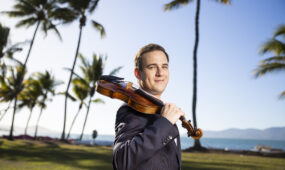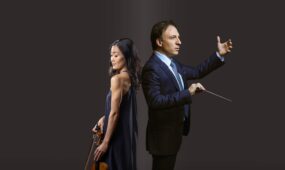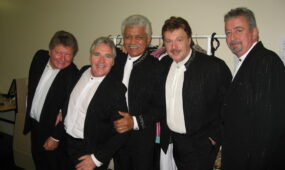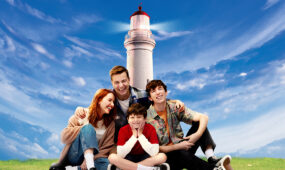How music became the love of my life
Music
Composer and music educator Paul Rissmann’s first words were ‘record player’. Here, he tells how music became his passion, and reveals how creative music projects can help young people achieve something beyond their wildest dreams.

As I enter my third year leading the Adelaide Symphony Orchestra’s Festival of Learning and Participation, it’s a great time to reflect on the role of the arts in education from a musical perspective.
When I talk to musicians the world over, it’s clear that early exposure to music leads not only to a life-long love for the art form, it can also greatly influence career choice. Use me as a case study: music has been my primary passion for as long as I can remember.
My mother tells me that as a baby, the first words to come out of my mouth were “record player”! That simultaneous love for both music and technology is just as strong today and its fusion now plays a huge part in my work.
I’ve often wondered if it is possible to trace my career choice all the way back to childhood. If so, could it simply be down to the fact that my mother used to sing to me every night to get me to sleep?
I was lucky enough to experience live music every day, and being absorbed in sound felt as natural as breathing.
My childhood was full of music. In primary school, I played recorder; in high school, I was given a bigger instrument and played in band and orchestra in school, as well as regionally and nationally.
It was the most remarkably rich education. When people ask me what we need to do to fix music in schools, my answer is always the same – just give them what I experienced as a teenager growing up in the west of Scotland. And I should point out, I wasn’t at a fancy private school; I was educated in the state system – so it was all provided for free.
Fast-forward to my graduation, where after six years of elite conservatoire education I should have felt like the world of music was my oyster, but something didn’t feel quite right.
For starters, the instrument in which I had become skilled – the classical saxophone – was unorthodox. It has a beautiful sound, but in the great history of music it’s practically a baby (the only thing younger than it is the synthesiser). So, at best, the classical saxophone offered a limited career path as it features in only a small and fairly abstract repertoire.
“But what about jazz?” I hear you cry. “You play the sax – it’s the king of jazz.”
Well, I liked playing in big-band for fun, but my passion has always been with the orchestra. Sadly, the saxophone never found a permanent chair in the woodwind section; to this day it’s nothing more than an occasional guest in symphonic music.
By my mid-20s, after playing one too many gigs of Ravel’s “Bolero”, I started to question if there was more to life. Crucially, I wondered how I could I feel more connected to an audience and actually make a difference with my music.
What I didn’t realise at the time was that my love for the saxophone had really set me up with everything I would need for the career that would soon follow, because I’d learned to program my own concerts and talk to audiences about the completely unknown saxophone repertoire – I mean, really, who has ever heard of Pierre-Max Dubois?
I’d also started to compose my own music and I adored working creatively with young people, exploring ways for us to make music together.
If you recounted any of those things to a jazz or folk musician, they’d simply say, “Of course, that’s what we do every day of the week”, but in the world of classical music, things are different.
Think about the orchestra: if you took a photo of a symphonic concert today, and then applied the right kind of Instagram filter to it, that picture could be of any orchestral event in the last 200 years; the only thing that would give it away is people’s haircuts! The look and format of an orchestral concert has barely changed.
So if Beethoven was brought back to life right now, he’d have no idea what to do with an iPhone, but I bet he’d feel right at home at a gig in the Town Hall.

Paul Rissmann presenting the family show ‘The Beat of Your Feet’ during the ASO’s Festival of Learning and Participation.
Even though the rituals of the adult orchestral experience have remained more or less unchanged, what orchestras are now providing for young people would be unrecognisable to Beethoven – and that’s entirely down to the evolution of creative and inclusive orchestral education programs.
By a stroke of I luck, I graduated just at the right at the time in the UK, when huge investment was encouraging orchestras to develop these new types of initiatives. When I got a call from the education department of the London Symphony Orchestra to help it out at the last minute, my life changed forever.
Overnight, I found myself in some of the most challenging environments. I worked on projects in schools in the east end of London, and in community centres and hospitals. I made projects for young people whose visual impairment was the least of their worries.
We welcomed asylum seekers by making music with them, and composed a symphony with people recovering from addiction to alcohol and drugs – and through all this work, being a professional musician suddenly made perfect sense.
I felt like I had purpose. I was no longer some kid sitting on a stage playing a 60-second solo by Ravel – I was actually making a tangible difference to people’s lives.
Of course, that’s exactly what the education department of every arts organisation aspires to do every day of the week.
Nowadays, however, in a world dominated by hashtags, buzzwords and political correctness, some organisations shy away from using the word “education”. To them, it’s become a dirty word, so it gets sugar-coated as learning or community engagement. But to me, they are all the same thing, and as a proud educationalist I have no issue with the word as long as it contains one essential ingredient – creativity.
Last year, here in Adelaide, the ASO launched its Petrushka Project, and this included creativity on the most extraordinary scale. We took Stravinsky’s ground-breaking ballet score and removed 50 per cent of his music. Then, supported by players from the ASO, young musicians created their own music incorporating ideas borrowed from Stravinsky. We inserted their work into Stravinsky’s ballet, and the young people performed their music on stage alongside the full forces of the ASO to make a performance of Petrushka that was unique – half of it was the original score and half of it was composed by school students.
The sense of pride and ownership in what the young people made was so great that they performed entirely from memory. Their concert was stunning.
This wasn’t just a run-of-the-mill schools project – this was music-making at the highest possible level, with young people achieving something far beyond their wildest dreams. They weren’t just instrumental performers, they’d become composers and directors, too, and were charged with the responsibility of giving the performance of their life with the ASO.
I think projects like that define what an orchestra, or any arts organisation, should do through their education work – they have a responsibility to take your breath away.
In the orchestral world, we are now living through a period of great change. As orchestras strive to redefine their role in the 21st century (and better serve their communities), that shift in direction and diversity in work is being driven directly by their education programs, and slowly – very slowly – the concert experience is also beginning to change.
Soon after I started working in schools with orchestras, I got invitations to program and present symphonic concerts for young people, too. This was a thrilling opportunity – imagine getting to introduce a whole new generation to music that you love, really love, played by an amazing ensemble.
The fatal flaw in many of the children’s concerts I had seen in the past was that they just weren’t pitched correctly, so I began to experiment by making concerts targeted at very specific age groups: the under fives, those aged five to seven and seven to 12, 13-year-olds only and so on. But I quickly ran into several problems.
You can’t just throw the orchestra at young people and expect them to engage with the experience. We can do so much better than that
The passive nature of sitting in a concert hall just didn’t fit with a young audience that was being brought up on a diet of songs that were less than three minutes a pop.
Secondly, due to the vast size of the orchestra, the static nature of the orchestral concert was visually less appealing. Young people are extremely sophisticated consumers of digital content; could they ever imagine going to a gig without LED screens, fancy lighting or Taylor Swift wearing next to nothing?
But worst of all, in the UK at least, music was being marginalised in the school curriculum. In the primary school especially, non-specialist teachers just weren’t being given the proper training to confidently deliver music lessons.
After a string of government policies which valued only maths and language and aspired to turn every child into a merchant banker, schools were increasingly reluctant to allocate quality time to the arts.
So how much impact could my orchestral concerts have on a young person’s life?
The two essential ingredients I’ve found that ensure a meaningful and successful orchestral performance for young people are preparation and participation.
I’ve always believed you can’t just throw the orchestra at young people and expect them to engage with the experience. We can do so much better than that, and everything has to begin not with the school children but with their teachers. So, a school concert should really be regarded as the culmination of a creative schools project.
I absolutely love working with the non-specialist primary school teacher, especially the one who says: “I am terrified to be here. I’m not musical. I don’t know anything about music. I can’t do it.” I know if I can inspire that teacher to make music and give them confidence, then they’ll take that love straight back to their class.
And the way to do it isn’t by bamboozling them (or their kids) with a ton of facts or dates about a composer, such as Mozart; it’s about finding a way for them to experiment and be hands-on by playing Mozart’s melodies or harmonies or rhythms. That has to be delivered in a way that is so immediate and so straight-forward that the non-specialist teacher feels empowered to give it a go.
But then magically, Mozart’s music ceases to be this precious piece of high art that has to be revered, and instead it becomes part of a noisy and messy activity in school using classroom percussion.
Having been creative with his music, when those kids actually come along to hear the orchestra play Mozart, they are so much more invested in the experience; they have a direct connection to the orchestra.
The best letter I ever received after one of my schools’ concerts was from a child who asked: “How come the orchestra knew my tune?” The barrier between a great work of art and music delivered in the school was gone.
The orchestra has an important role to play in the 21st century, but it can no longer be concerned just with re-creating the music of dead Europeans
The final piece of my story involves participation but not in the classroom – in the concert venue.
While I’m in Adelaide, I’m performing 13 concerts for young people from kindy all the way up to high school. In every one of those shows there is a participatory element for the audience – so our concerts are not about the kids sitting in the Town Hall passively listening to the ASO, they are an open invitation for young people to perform in a meaningful way with the ASO.
Sometimes we do that using existing orchestral repertoire, but in the last 10 years, I’ve also started to compose a whole series of works for young audiences to perform with professional musicians. The most sophisticated example of that features in our Out of This World concert, where school children will perform my concert suite inspired by Alice in Wonderland. It’s a substantial piece and a real challenge for everyone involved, but it’s designed especially so that the young audience feels equal to the orchestra in their performance. A work like that also allows us to remove another barrier – the one between stage and the audience – since everyone in the hall is making music together.
I passionately believe that the orchestra has an important role to play in the 21st century, but it can no longer be concerned just with re-creating the music of dead Europeans.
The modern symphony orchestra should operate as an amazingly flexible body of musicians who are able to serve all of its community – or city, or state – both on and off the concert platform. And most importantly, all its activity should have equal status, irrespective of whether you call it education, engagement or a masters concert.

Get InReview in your inbox – free each Saturday. Local arts and culture – covered.
Thanks for signing up to the InReview newsletter.
That’s why I am so thrilled to going on that journey with an orchestra like the ASO. Who knows where we’ll end up, but I hope we touch many people’s lives on the way.
Paul Rissmann is a British composer, concert presenter and music educator. He will lead the ASO’s Festival of Learning and Participation from June 2-10. The program, which can be viewed here, includes In Flight, a collaboration with the Elder Conservatorium of Music, on June 2 at Elder Hall, and family performances of Out of This World (June 7) and Happy Town (June 10) at the Town Hall.
Support local arts journalism
Your support will help us continue the important work of InReview in publishing free professional journalism that celebrates, interrogates and amplifies arts and culture in South Australia.
Donate Here






Comments
Show comments Hide comments